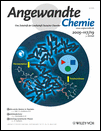Fabrication of Chemical Microarrays by Efficient Immobilization of Hydrazide-Linked Substances on Epoxide-Coated Glass Surfaces†
Myung-ryul Lee
Department of Chemistry, Yonsei University, Seoul 120-749, Korea, Fax: (+82) 2-364-7050
Search for more papers by this authorInjae Shin Prof. Dr.
Department of Chemistry, Yonsei University, Seoul 120-749, Korea, Fax: (+82) 2-364-7050
Search for more papers by this authorMyung-ryul Lee
Department of Chemistry, Yonsei University, Seoul 120-749, Korea, Fax: (+82) 2-364-7050
Search for more papers by this authorInjae Shin Prof. Dr.
Department of Chemistry, Yonsei University, Seoul 120-749, Korea, Fax: (+82) 2-364-7050
Search for more papers by this authorThis work was supported by a grant of the Center for Integrated Molecular Systems (KOSEF) and the Ministry of Science and Technology.
Graphical Abstract
Punktgenau fixiert: Eine neue, effiziente und einfache Immobilisierungstechnik für den Aufbau chemischer Mikroarrays wurde entwickelt. Diese Technik eignet sich zur positionsselektiven Anbindung verschiedenster Substanzen, darunter kleine Moleküle, Kohlenhydrate und Peptide, an Glasplättchen (siehe Bild). Die auf diese Art erhaltenen chemischen Mikroarrays wurden für das Screening der Bindung von Peptiden und kleinen Molekülen an Proteine genutzt.
Supporting Information
Supporting Information for this article is available on the WWW under http://www.wiley-vch.de/contents/jc_2001/2005/z462720_s.pdf or from the author.
Please note: The publisher is not responsible for the content or functionality of any supporting information supplied by the authors. Any queries (other than missing content) should be directed to the corresponding author for the article.
References
- 1For recent reviews, see:
- 1aR. S. Lokey, Curr. Opin. Chem. Biol. 2003, 7, 91;
- 1bC. A. MacRae, R. T. Peterson, Chem. Biol. 2003, 10, 901;
- 1cA. C. Bishop, O. Buzko, K. M. Shokat, Trends Cell Biol. 2001, 11, 167;
- 1dB. R. Stockwell, Trends Biotechnol. 2000, 18, 449.
- 2For recent reviews of DNA microarrays, see:
- 2aS. V. Chittur, Comb. Chem. High Throughput Screening 2004, 7, 531;
- 2bD. J. Villeneuve, A. M. Parissenti, Curr. Top. Med. Chem. 2004, 4, 1329;
- 2cW. H. Koch, Nat. Rev. Drug Discovery 2004, 3, 749.
- 3For recent reviews of protein microarrays, see:
- 3aF. X. Zhou, J. Bonin, P. F. Predki, Comb. Chem. High Throughput Screening 2004, 7, 539;
- 3bH. Zhu, M. Snyder, Curr. Opin. Chem. Biol. 2003, 7, 55;
- 3cD. S. Wilson, S. Nock, Angew. Chem. 2003, 115, 510;
10.1002/ange.200390118 Google ScholarAngew. Chem. Int. Ed. 2003, 42, 494;
- 3dT. Kodadek, Chem. Biol. 2001, 8, 105;
- 3eS. R. Weinberger, E. A. Dalmasso, E. T. Fung, Curr. Opin. Chem. Biol. 2001, 5, 86.
- 4For reviews of carbohydrate microarrays, see:
- 4aI. Shin, J. W. Cho, D. W. Boo, Comb. Chem. High Throughput Screening 2004, 7, 565;
- 4bI. Shin, S. Park, M.-R. Lee, Chem. Eur. J. 2005, in press;
- 4cT. Feizi, W. Chai, Nat. Rev. Mol. Cell Biol. 2004, 5, 582;
- 4dT. Feizi, F. Fazio, W. Chai, C.-H. Wong, Curr. Opin. Struct. Biol. 2003, 13, 637.
- 5
- 5aD. P. Walsh, Y. T. Chang, Comb. Chem. High Throughput Screening 2004, 7, 565;
- 5bA. N. Koehler, A. F. Shamji, S. L. Schreiber, J. Am. Chem. Soc. 2003, 125, 8420;
- 5cM. Köhn, R. Wacker, C. Peters, H. Schröder, L. Soulère, R. Breinbauer, C. M. Niemeyer, H. Waldmann, Angew. Chem. 2003, 115, 6010;
10.1002/ange.200352877 Google ScholarAngew. Chem. Int. Ed. 2003, 42, 5830, and references therein;
- 5dF. G. Kuruvilla, A. F. Shamji, S. M. Sternson, P. J. Hergenrother, S. L. Schreiber, Nature 2002, 416, 653;
- 5eK. S. Lam, M. Renil, Curr. Opin. Chem. Biol. 2002, 6, 353.
- 6
- 6aF. Stieber, U. Grether, H. Waldmann, Chem. Eur. J. 2003, 9, 3270;
- 6bF. Stieber, R. Mazitschek, N. Soric, A. Giannis, H. Waldmann, Angew. Chem. 2002, 114, 4951;
10.1002/ange.200290039 Google ScholarAngew. Chem. Int. Ed. 2002, 41, 4757;
- 6cC. Rosenbaum, H. Waldmann, Tetrahedron Lett. 2001, 42, 5677.
- 7M. L. Lesaicherre, R. Y. Lue, G. Y. Chen, Q. Zhu, S. Q. Yao, J. Am. Chem. Soc. 2002, 124, 8768.
- 8See the Supporting Information for experimental details.
- 9I. E. Liener, N. Sharon, I. J. Goldstein, The Lectins: Properties, Functions, and Applications in Biology and Medicine, Academic Press, New York, 1986.
- 10T. G. M. Schmidt, A. Skerra, Protein Eng. 1993, 6, 109.
- 11T. G. M. Schmidt, J. Koepke, R. Frank, A. Skerra, J. Mol. Biol. 1996, 255, 753.
- 12
- 12aW. G. Lewis, L. G. Green, F. Grynszpan, Z. Radić, P. R. Carlier, P. Taylor, M. G. Finn, K. B. Sharpless, Angew. Chem. 2002, 114, 1095;
Angew. Chem. Int. Ed. 2002, 41, 1053;
10.1002/1521-3773(20020315)41:6<1053::AID-ANIE1053>3.0.CO;2-4 CAS PubMed Web of Science® Google Scholar
- 12bZ. Radić, P. Taylor, J. Biol. Chem. 2001, 276, 4622.
- 13
- 13aJ. J. Devlin, L. C. Panganiban, P. E. Devlin, Science 1990, 249, 404;
- 13bK. S. Lam, S. E. Salmon, E. M. Hersh, V. J. Hruby, W. M. Kazmierski, R. J. Knapp, Nature 1991, 354, 82.
Citing Literature
This is the
German version
of Angewandte Chemie.
Note for articles published since 1962:
Do not cite this version alone.
Take me to the International Edition version with citable page numbers, DOI, and citation export.
We apologize for the inconvenience.





